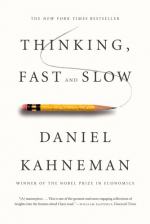
|
| Name: _________________________ | Period: ___________________ |
This quiz consists of 5 multiple choice and 5 short answer questions through Chapters 10 - 14.
Multiple Choice Questions
1. Where was Albert Michotte from?
(a) Norway.
(b) France.
(c) Sweden.
(d) Belgium.
2. When the author demonstrates enlisting cognitive ease when writing, he gives two statements about Adolf Hitler. Which of these statements APPEARED to be the most legitimate?
(a) The statement in italics.
(b) The statement in bold print.
(c) The statement in small print.
(d) The statement in wide-set print.
3. The author asserts in Chapter 1 that anything that occupies your working memory reduces what?
(a) The availability cascade.
(b) Anchoring effects.
(c) Your emotional reactions.
(d) Your ability to think.
4. When did the Yom Kippur War break out?
(a) 1999.
(b) 1965.
(c) 1973.
(d) 1953.
5. What illusion does the author demonstrate by presenting lines that appear to be different sizes but are in fact the same?
(a) The Muller-Lyer illusion.
(b) The illusion of Narrative Fallacy.
(c) The Executive Control illusion.
(d) The Anchoring illusion.
Short Answer Questions
1. Who is declared by the author as the hero of the book in Chapter 1?
2. Who coined the term "mere exposure effect"?
3. The author provides an excerpt related to "norm theory" that comes from an essay he had written with what psychologist?
4. What statistician illustrated the ease with which people see patterns where none exist?
5. Who introduced the labels System 1 and System 2 as systems of the mind?
|
This section contains 231 words (approx. 1 page at 300 words per page) |

|




